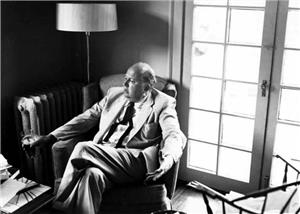On August 1, 1963, Pulitzer Prize winning poet and University of Washington English professor Theodore Roethke (1908-1963) is found dead in a swimming pool at the Bainbridge Island home of Prentice (1900-1996) and Virginia (1902-1989) Bloedel, where Roethke was visiting. While rumors of Roethke's legendary drinking contribute to tales about the circumstances of his death, the coroner lists the official cause as a coronary occlusion. Despite stories that the Bloedels fill the pool immediately after Roethke's death, it will remain until 1981. Once filled, the site will be occupied for a few years by a garden installation designed by Richard Haag (b. 1923) and then, from 1986, by a Sand and Rock Garden designed by landscape architect Dr. Koichi Kawana (1930-1990).
An Outsize Persona
Theodore Roethke was born in Saginaw, Michigan, and attended the University of Michigan at Ann Arbor, where he received both bachelor's and master's degrees. After holding teaching positions at Lafayette College in Easton, Pennsylvania, and at Michigan State, Roethke suffered from an episode of mental illness in 1935 that caused him to spend two months in a sanitarium. After his stay there, he took a position at Pennsylvania State College (later University) and taught there until 1943. He was a professor at Bennington College in Vermont until 1945, and then came to the University of Washington in 1948. Mental issues continued to plague him through his life, leading to several more breakdowns. Despite those issues, Roethke produced an impressive body of work that brought him many accolades.
He won the 1954 Pulitzer Prize for The Waking, a collection of poetry published in 1953. After the publication of Words for the Wind, he received the Bollingen Prize in 1958 and the National Book Award in 1959. He would receive a second National Book Award posthumously in 1965 for The Far Field. Roethke was awarded two Guggenheim Fellowships; the Shelley Award, given by the Poetry Society of America; and an award from the American Academy of Arts and Letters. While he achieved acclaim as a poet, Roethke was still dedicated to his teaching career and was given the title "Poet in Residence" by the University of Washington Board of Regents the year before his death.
In addition to his literary reputation, Roethke was well-known for an outsize persona -- and person. At six-foot-three and more than 200 pounds, his New York Times obituary reported he was nicknamed "the dancing bear" ("Theodore Roethke, 55, ..."). He was rumored to have had several relationships with students, and he eventually married a former Bennington student, Beatrice O'Connell, in 1953. He was also widely known as a heavy drinker -- indeed, more than a half-century after his death his portrait still hung at the Blue Moon Tavern, one of his favorite haunts in the University District.
A Death Surrounded by Rumors
Roethke's reputation played a factor in the lore surrounding his death. While working on a new book, Roethke was spending the summer on Bainbridge Island, a ferry-ride across Puget Sound from Seattle. Prentice Bloedel, a timber industrialist and business leader, owned a nearby home with his wife Virginia Bloedel, an arts patron and supporter. Roethke and his wife were regular visitors at the Bloedel home, and on August 1, 1963, Roethke was enjoying an afternoon of socializing and swimming with Virginia and her daughter Eulalie as his wife shopped in Seattle.
Stories have long persisted that Roethke was drinking shortly before his death, and one long-time apocryphal tale has Roethke finishing a cocktail for every lap he swam over the course of the afternoon. However, news outlets such as The New York Times and The Seattle Times reported in their obituaries of Roethke that he had been in the shallow end of the pool when Virginia and Eulalie Bloedel found him. Allan Seager, in his 1968 biography of the poet, recounted that Roethke had fixed mint juleps and had begun swimming at the shallow end of the pool while the women dangled their feet on the deep side. They eventually noticed him floating face down, blue and unconscious. Although mouth-to-mouth resuscitation was attempted, a doctor who was called pronounced him dead at the scene. Ultimately, the coroner concluded the death was caused by a coronary occlusion.
Transformation over Time
Roethke's ashes were buried in Saginaw, Michigan, alongside the grave of his parents. The property where he died later became the Bloedel Reserve. The Bloedels had bought the vast 150-acre estate on northern Bainbridge Island (including the house designed by J. Lister Holmes that they occupied until 1987) in 1951, and over the years the property was transformed from a logging site into a mosaic of gardens and landscapes.
Renowned landscape architects Thomas Church, Richard Haag, Koichi Kawana, Fujitaro Kubota, and Iain Robertson all contributed designs to what became the Bloedel Reserve. The Bloedels donated the property to the University of Washington in 1970, and then in 1985 the Bloedel-endowed Arbor Fund purchased the Reserve, continuing to manage it as of 2017.
For many years, a story circulated that after Roethke's tragic death the Bloedels immediately filled the pool with soil to remove any memory of the incident. In fact, the pool was not filled until 18 years after his death, in 1981. Well-known landscape architect Richard Haag designed the Garden of Planes in the space. Prentice Bloedel imagined Haag's design only as a possible model for the space, however, and the installation did not prove permanent. Eventually Bloedel and the Reserve trustees decided that Garden of Planes did not fit the Reserve's purposes, and chose to create an installation more in harmony with the Japanese Gardens surrounding the space.
After a larger-scale Master Planning project to create a more cohesive landscape and solve circulation issues in the Reserve, the landscape became a Sand and Rock Garden in 1986. The Dr. Koichi Kawana-designed garden remained there in 2017, in the same spot as Roethke's last swim.

